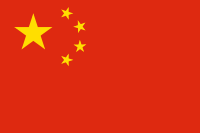Population
China has the largest population of any country in the world with 1.3 billion people; that equates to 20% of Earth's population.

China is one of the most oldest continuous major world civilization. The name is name derived from the Persian name "Cin." For more than 40 centuries, China and its people created strong philosophies, traditions, and values. When the Han dynasty took power 2,200 years ago, they created a unique military power that created a "golden age" of arts, politics, and technology. To this day, 92% of people in China are descendants of the Han.
More recently, from 1949 to 1976, the People's Republic of China, most commonly known as simply China, enforced state control of the economy. Around 1979, the Chinese economy was reformed to allow for competition, focusing on market-oriented development. Since 1979, market output quadrupled and living standards for much of the population have improved. However, heavy political controls remain in place.
China has the largest population of any country in the world with 1.3 billion people; that equates to 20% of Earth's population.
China is located in the east of the Asian continent, on the western shore of the Pacific Ocean. It covers an area of about 9.6 million square km. China is the fourth largest country in the world, after Russia, Canada, and the United States. Most of the population of China lives in the coastal regions, and these are the most economically developed. 94% of people live in the eastern third of the country. Shandong province, which has a mild climate, has a population of 90 million. Tibet, which has a harsh client, has a population of less than 3 million.
China has a climate dominated by dry seasons and wet monsoons, which leads to clear temperature differences in winter and summer. Overall, the climate is very diverse, ranging from tropical in the south to subartic in the north.
China's economy is huge—and expanding rapidly—with an average of 8% growth in Gross Domestic Product (GDP) per annum. Since 1978, the GDP has increased tenfold, and in 2010, the economy had an estimated GDP of $9.872 trillion—third behind the European Union and the United States. In 2010, China became the world's largest exporter. GDP is heavily dependent on exports.
Even as the government's hold on the economy lessens, per capita income is below the world average. The Chinese government is dealing with rapid modernization of the country, which includes people moving from the countryside to urban areas at a large pace. More than 200 million rural laborers have relocated to urban areas to find work. It will be difficult for China to sustain the needed economic growth for these new entrants into the workplace. China's unemployment rate was reported at 4.20% in March 2010.
Additionally, a high domestic savings rate corresponds to low demand for products in China, meaning that China cannot stimulate its own growth. Some economic productivity is lost to corruption in the government. Additionally, environmental and social damage of the country modernizing quickly will have real economic impacts in the future.
Major industries
Iron and Steel Industry: China is the world's largest producer, importer and consumer of steel. The country's steel consumption in 2003 reached a level of 250 million tons and is expected to jump to 280 million tons by the end of 2011.
Information Technology: The Chinese IT industry contributed significantly to the country's rapid economic growth in recent years. The China Centre for Information Industry Development (CCID) expects that entertainment electronics, auto electronics, electronic medical equipment, digital information content and digital TV will be the major high growth areas for the IT sector.
Textile Industry: The textile industry is one of China's traditional pillar industries. The country commands over more than 15% of the nearly $400 billion global textile market.
Natural Resources
Natural resources include: Coal, iron ore, petroleum, natural gas, manganese, aluminium, rare earth elements and hydro-power potential.
Standard Chinese or Mandarin is the official language. There are many other languages spoken, however, including: Yue (Cantonese), Wu (Shanghainese), Minnan (Hokkien-Taiwanese), Xiang, Gan, Hakka, and many other minority languages and dialects.
The Chinese legal system is based on a civil law system that is derived from Soviet principles. The legislative branch of government reserves the right to interpret statues, and judicial branch's review of legislation is ambiguous.
The Chinese have a Chief of State, President HU Jintao and Vice President XI Jinping. Elections are held every five years, with the president and vice-president elected by the National People's Congress. The only political party is the Chinese Communist Party, although there are officially eight smaller parties which are controlled by the Chinese Communist Party. No real political opposition groups exist. The capital city is Bejing.
China is officially atheist as of 2002. Buddhism, Taoism, Christian (3-4%), and Muslim (1-2%) religions are all practiced.
In 2011, the Guardian newspaper published an info-graphic comparing China to the United States. It can be accessed at the Guardian's website.